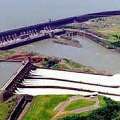 巴西「國家空間科學研究院」(INPE)科學家在一份新報告中指出,大型水壩會將溫室氣體甲烷排入大氣之中,加劇全球暖化,因此提議從大型水壩中捕集甲烷並作為發電之途。
巴西「國家空間科學研究院」(INPE)科學家在一份新報告中指出,大型水壩會將溫室氣體甲烷排入大氣之中,加劇全球暖化,因此提議從大型水壩中捕集甲烷並作為發電之途。
研究人員在報告中說明這個回收甲烷發展再生能源計劃,未來將可減少人類對環境的影響,如建造新的大型水壩、降低水壩現行的甲烷排放量,以及使用非永續經營的石化燃料和天然氣等等。
利馬(Ivan Lima)博士在報告中的統計資料顯示,在人類行為加速暖化的比例中,全球5萬2000座大型水壩就超過4%以上,另外水壩也是人類行為中最大的甲烷排放源,占總排放量25%左右。
「國際水力發電協會」(IHA)認為,若只以水壩表面測得的溫室氣體排放量來討論,恐怕會有誤導之虞;這些測量數值應以總體排放量計算為佳。另外,在計算「淨排放量」方面,則必須考慮到水壩興建前生態尚處原貌時的排放量才是。
按此連結,可閱讀更多水壩與氣候變遷關聯性的資訊。
Scientists from Brazil's National Institute for Space Research, INPE, have published a new study showing that large dams contribute to global warming by releasing the greenhouse gas methane into the atmosphere. The authors propose capturing the methane and using it to generate electricity.
The immediate benefits of recovering methane from large dams for renewable energy production is the mitigation of human impacts like the construction of new large dams, avoidance of the actual methane emissions from large dams, and the use of unsustainable fossil fuels and natural gas reserves, the authors explain in their study.
Dr. Ivan Lima's calculations imply that the world's 52,000 large dams contribute more than four percent of the total warming impact of human activities, and that dam reservoirs are the largest single source of human-caused methane emissions, contributing around a quarter of these emissions.
The International Hydropower Association, IHA, says considering only total greenhouse gases measured at the surface of reservoirs can be misleading; these measurements should be considered as "gross" emissions. "Net" emissions for which dams are responsible must consider the emissions from ecosystems before the creation of a reservoir when the land was in its natural state.
全文及圖片詳見 ENS報導




